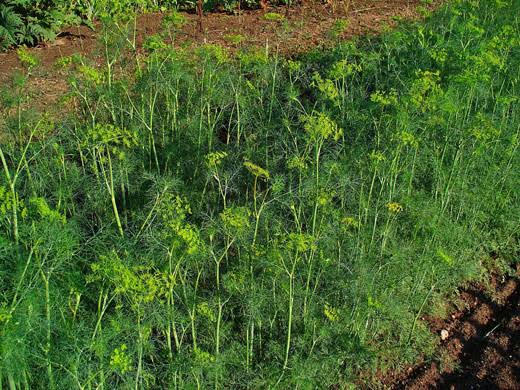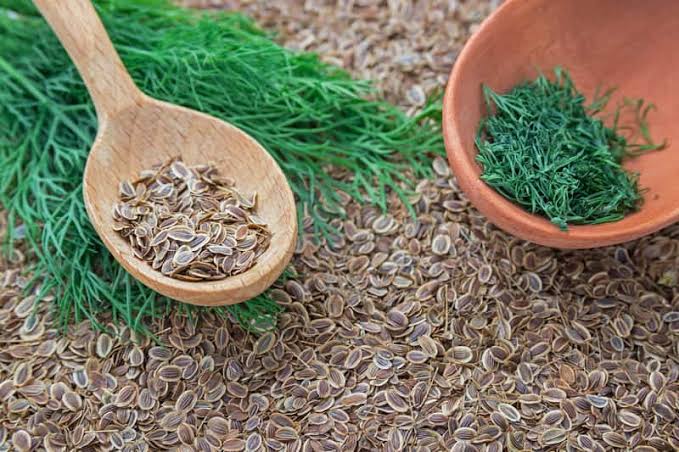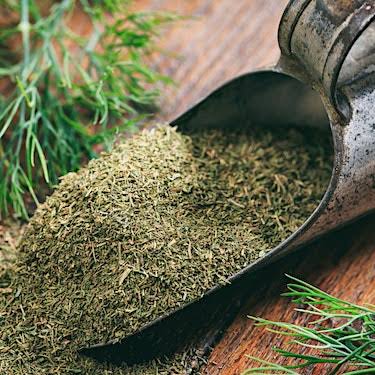Dill seasoning is a special kind of spice that lots of people use in cooking to make their food taste better. It is made from a plant called dill, which has feathery green leaves and tiny yellow flowers. Dill has a fresh and tangy flavor that can make your dishes taste really yummy.
People have been using dill seasoning for a very long time, even way back in ancient times. They liked the way it made their food taste, and they also believed that dill had some special powers to help with things like digestion and bad breath. Whether or not it has those powers, we can’t say for sure, but it sure does make food taste great!
You can find dill seasoning in different forms. One of the most common ways to use it is as dried dill. Dried dill looks like tiny green flakes, and you can sprinkle it on all sorts of dishes. Some people love to put it on fish, especially salmon, because it pairs really nicely with the fish’s natural flavor. It’s also fantastic on potatoes, giving them a fresh and herby taste.
Another way to use dill is by using fresh dill weed. Fresh dill has a more intense flavor than dried dill, and it’s often used in salads and pickles. If you’ve ever had dill pickles, you’ve probably tasted the bright and tangy flavor of fresh dill. It gives pickles that famous dill pickle taste!
People use dill seasoning in many different types of cuisine. It’s very popular in Scandinavian cooking, where they make things like gravlax, a type of cured salmon with dill. In Russia, they use it in a delicious soup called borscht. And in the Mediterranean, dill is often found in dishes like tzatziki, a creamy yogurt sauce.
One of the great things about dill is that it’s not just tasty; it’s also good for you. Dill has some healthy vitamins and minerals, like vitamin C and calcium. Some people also think it might have some benefits for your digestion, just like the folks from ancient times believed.
So, whether you are just sprinkling dried dill on your roasted vegetables or adding fresh dill to your salad, you’re not just making your food taste better, but you might also be giving your body a little boost of goodness. Dill seasoning is a simple yet wonderful way to make your meals more flavorful and enjoyable. Try it out in your kitchen, and you’ll discover how this little herb can add a burst of freshness to your dishes.
Read Also: Cat | Breeds & Facts
Growing Dill

Growing dill in your garden or even in a pot on your balcony is a rewarding and straightforward experience. Dill is a fragrant herb with feathery leaves and tiny yellow flowers, and it’s not only a culinary delight but also a great addition to your garden. Here are some simple steps to help you grow dill successfully:
1. Choose the Right Location: Select a sunny spot in your garden or on your balcony for your dill plants. Dill thrives in full sunlight, which means it needs at least 6-8 hours of direct sunlight each day.
2. Prepare the Soil: Dill prefers well-drained, slightly acidic to neutral soil. Ensure that the soil is loose and fertile. You can improve the soil by adding organic matter, such as compost, to enhance its texture and nutrient content.
3. Planting Dill Seeds: Dill is typically grown from seeds. You can sow dill seeds directly in the garden or in containers. Plant the seeds about ¼ to ½ inch deep and space them 12-18 inches apart. Dill has a long taproot, so it’s best to plant it where it will grow rather than transplanting it.
4. Watering: Keep the soil consistently moist but not waterlogged, especially during the germination period. Once dill plants are established, they are relatively drought-tolerant, but consistent moisture will yield better results.
5. Thinning and Pruning: When your dill plants are about 3-4 inches tall, thin them out to maintain proper spacing. This helps prevent overcrowding, which can lead to disease. Prune or harvest dill leaves and stems as needed throughout the growing season to encourage bushier growth.
6. Mulch: Applying a layer of organic mulch around your dill plants helps retain soil moisture, suppress weeds, and keep the soil temperature stable.
7. Support and Protection: As dill plants grow tall and start to flower, they can become top-heavy and may need support. Use stakes or a garden trellis to prevent them from falling over. Also, be on the lookout for pests like aphids and caterpillars, and take appropriate measures to protect your plants.
8. Harvesting Dill: You can start harvesting dill leaves when the plants are about 8-12 inches tall. Snip the leaves and stems as needed, but avoid harvesting more than one-third of the plant at a time. Dill leaves have the best flavor when harvested before the plant flowers. If you want to collect dill seeds, allow the flowers to mature and turn brown, then collect the seeds.
9. Saving Dill Seeds: To save dill seeds, cut the flower heads when they turn brown but before they shatter. Place the heads in a paper bag and hang them upside down in a dry, well-ventilated area. Once the seeds are fully dry, remove them from the heads and store them in an airtight container.
Growing dill is a delightful experience that can add fresh, aromatic flavor to your dishes. Whether you’re using it in pickles, salads, or as a garnish, homegrown dill is a wonderful addition to your kitchen.
12 Health Benefits of Dill Seasoning
Dill seasoning not only adds a delightful flavor to your dishes but also offers several potential health benefits due to its natural compounds and nutritional properties. Here are 12 health benefits associated with dill seasoning:
1. Digestive Aid: Dill contains compounds that may help alleviate digestive issues like indigestion, bloating, and gas.
2. Antioxidant Properties: Dill seasoning is rich in antioxidants, which can help protect your cells from damage caused by harmful free radicals.
3. Anti-Inflammatory: Dill contains anti-inflammatory compounds that may help reduce inflammation and related conditions.
4. Bone Health: Dill is a source of calcium, which is essential for maintaining strong and healthy bones.
5. Blood Pressure Regulation: Some components in dill may help regulate blood pressure, contributing to cardiovascular health.
6. Immune System Support: Dill contains vitamin C, which plays a role in supporting the immune system and keeping you healthy.
7. Antibacterial Effects: Dill has natural antibacterial properties, which may help combat harmful bacteria in the body.
8. Mouth Freshener: Chewing on dill seeds or using dill-infused mouthwash can help freshen your breath.
9. Respiratory Health: Dill has been used traditionally to soothe respiratory conditions like coughs and bronchitis.
10. Anti-Cancer Potential: Some studies suggest that dill may contain compounds that could inhibit the growth of cancer cells, although more research is needed.
11. Diuretic Properties: Dill may act as a diuretic, promoting the production of urine and aiding in the removal of excess fluids from the body.
12. Stress Reduction: The aroma of dill has a calming effect and may help reduce stress and anxiety levels.
It’s important to note that while dill seasoning can be a flavorful and potentially healthful addition to your diet, it should not be used as a replacement for medical treatment or a balanced diet. As with any herb or spice, moderation is key, and individual reactions can vary. If you have specific health concerns or conditions, it is advisable to consult with a healthcare professional for personalized guidance.
Read Also: Rare Facts of Bobcats (Lynx rufus)
Dill Seeds

Dill seeds are tiny, but they pack a big punch when it comes to flavor. These small seeds come from the dill plant, which is known for its feathery green leaves and fragrant aroma. Dill seeds have been used in cooking for a very long time, and they add a unique and delightful taste to many dishes.
One of the most popular uses for dill seeds is in pickling. When you want to make pickles, you often add dill seeds to the brine (the salty, vinegary liquid). These seeds infuse the pickles with a sharp, tangy flavor that we all know and love. If you’ve ever bitten into a crunchy dill pickle, you’ve tasted the zesty goodness of dill seeds.
Dill seeds are not just for pickles, though. They are a versatile spice that can enhance the taste of various foods. Many people use dill seeds to season fish, such as salmon or trout. The seeds complement the fish’s natural flavors and give it a fresh and herby kick. It’s like a burst of summer in every bite!
If you enjoy making homemade bread or crackers, dill seeds can be a secret ingredient to take your creations to the next level. Just sprinkle a few dill seeds into your dough before baking, and you’ll be amazed at how they transform your baked goods with their aromatic taste.
In some cuisines, especially in Indian and Middle Eastern cooking, dill seeds are used in spice blends. These blends, known as masalas or za’atar, often contain dill seeds along with other spices. They add complexity and depth to dishes like curries and grilled meats.
Dill seeds are not just about flavor; they have a history of being used for their potential health benefits as well. Some people believe that dill seeds can help with digestion and relieve stomach discomfort. While more research is needed to confirm these claims, it’s clear that dill seeds have been valued for both their taste and their potential wellness properties.
In addition, dill seeds may be small, but they play a significant role in the world of cooking. From pickles to fish dishes and even homemade bread, these tiny seeds bring a burst of flavor and aroma to a wide range of recipes. So, next time you’re in the kitchen, consider adding a pinch of dill seeds to elevate your culinary creations to new heights of taste and enjoyment.
Dried Dill

Dried dill, also known as dried dill weed, is a convenient and versatile herb that comes from the dill plant. It’s a fantastic way to enjoy the fresh and herby flavor of dill year-round, even when fresh dill is not in season. Dried dill is created by carefully drying the feathery leaves of the dill plant, preserving its distinctive taste.
One of the most common uses for dried dill is in seasoning dishes. It’s a great addition to many recipes, especially those that feature fish and seafood. Sprinkling a bit of dried dill on your salmon or shrimp can transform a simple meal into a flavorful culinary delight. The natural citrusy and slightly anise-like notes of dill add a refreshing kick to your food.
Dried dill is also a popular choice for flavoring salads, sauces, and dressings. If you’re making a creamy potato salad or a refreshing cucumber yogurt sauce (tzatziki), adding dried dill can give your dish that delightful dill taste without the need for fresh dill. It’s an easy way to infuse your recipes with a burst of flavor.
Homemade dips and spreads can benefit from dried dill as well. Whether you’re whipping up a batch of ranch dip or creating a flavorful cream cheese spread for your bagels, a pinch of dried dill can elevate the taste and make your creations stand out.
One of the advantages of using dried dill is its long shelf life. Unlike fresh herbs, which can spoil quickly, dried dill can be stored for a more extended period. Just keep it in a cool, dry place in an airtight container to maintain its flavor and potency.
Dried dill isn’t just about enhancing the taste of your dishes; it may also offer some potential health benefits. Some people believe that dill, in any form, may aid in digestion and help relieve stomach discomfort. While more research is needed to confirm these claims, dill has a long history of being used for its potential wellness properties.
In addition, dried dill is a kitchen essential that allows you to enjoy the wonderful flavor of dill year-round. Whether you’re seasoning fish, making salads, or creating dips and dressings, dried dill can add a burst of fresh and tangy flavor to your culinary creations. Plus, its long shelf life makes it a convenient pantry staple for any home cook.
Dill Leaves
Dill leaves, often referred to as dill weed, are the delicate and feathery green leaves of the dill plant. These leaves are prized for their fresh, herbaceous flavor and are a staple in many cuisines around the world. Dill leaves can add a burst of brightness and aroma to a wide range of dishes.
One of the most common uses of dill leaves is in salads. Chopped dill leaves can be sprinkled over green salads, potato salads, or pasta salads to impart a zesty and refreshing taste. Their bright green color and citrusy, slightly anise-like flavor make salads more vibrant and appealing.
Dill leaves are also frequently used in sauces and dressings. They are a key ingredient in classic dishes like tzatziki, a Greek yogurt sauce, where their fresh flavor complements the creamy yogurt and cucumbers. Additionally, dill leaves can be blended into herb-based salad dressings for a tangy and aromatic twist.
Fish and seafood dishes benefit greatly from dill leaves. Fresh dill leaves can be used as a garnish for grilled or baked fish, adding a burst of flavor and a touch of elegance. Dill is a classic pairing with salmon, enhancing the fish’s natural taste.
In pickling, dill leaves are often included to infuse the brine with their unique flavor. When you bite into a dill pickle, you can taste the distinct notes of dill leaves that give pickles their signature taste.
One wonderful aspect of dill leaves is their aromatic quality. Just brushing against fresh dill leaves releases a delightful scent that can instantly uplift your senses in the kitchen.
Dill leaves are not only used for their culinary appeal but also for potential health benefits. Some people believe that dill leaves may aid digestion and soothe an upset stomach. While these claims require further scientific research, dill leaves have a long history of being associated with wellness and herbal remedies.
However, dill leaves are a versatile and flavorful herb that can elevate the taste of numerous dishes. Whether you’re using them in salads, sauces, or as a garnish, dill leaves contribute a fresh and herbaceous quality that enhances your culinary creations. Their vibrant green color and aromatic aroma make them a must-have ingredient in any kitchen.
Read Also: What to Produce, How to Produce and For Whom to Produce
